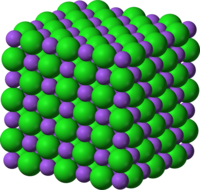
Photo from wikipedia
Being able to predict products’ degrees of crystallinity and thereby optimize their crystallization processes is of great significance for producing high-quality polymeric products in injection molding. However, it is rather… Click to show full abstract
Being able to predict products’ degrees of crystallinity and thereby optimize their crystallization processes is of great significance for producing high-quality polymeric products in injection molding. However, it is rather difficult to theoretically establish the relationship between the crystallization results and processing conditions (high cooling rates and pressures, strong and complex flow fields). Injection molding simulation software can simulate polymers’ density results during packing stage, and these predicted density results can be used to calculate polymers’ crystallinity results. Based on this idea, a novel method was proposed to predict the degrees of crystallinity for polymers during packing stage. In this method, pressure and temperature results are first simulated by an injection molding simulation software, and then the density results are calculated based on a pressure–volume–temperature model. Next, the crystallinity results are solved according to the densities of the fully crystalline part and the purely amorphous part. Finally, two case studies are conducted to verify the proposed crystallinity prediction method. Moreover, the effects of packing parameters (mold temperature, packing pressure, and packing time) on polymers’ crystallization behaviors are investigated. The experimental results show that the proposed method is correct and effective.
Journal Title: Proceedings of the Institution of Mechanical Engineers, Part B: Journal of Engineering Manufacture
Year Published: 2019
Link to full text (if available)
Share on Social Media: Sign Up to like & get
recommendations!